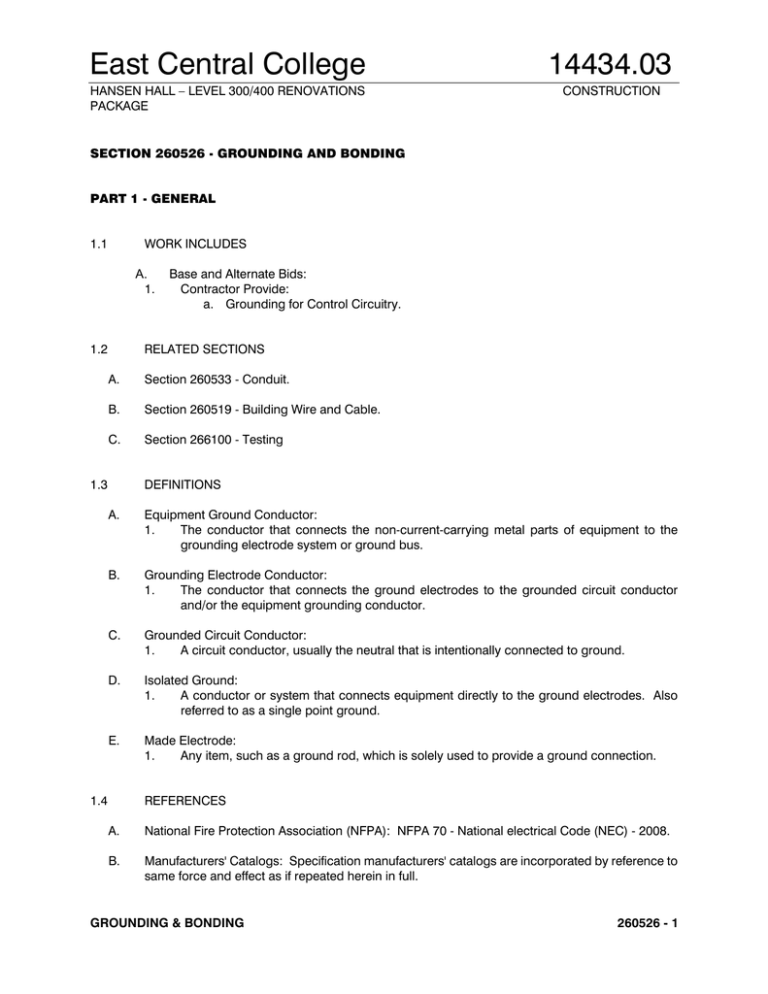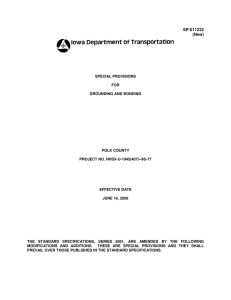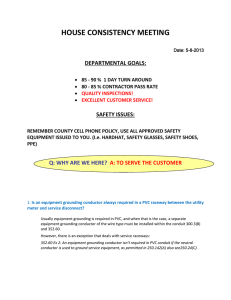DIVISION 16 - ELECTRICAL
advertisement

East Central College 14434.03 HANSEN HALL – LEVEL 300/400 RENOVATIONS PACKAGE CONSTRUCTION SECTION 260526 - GROUNDING AND BONDING PART 1 - GENERAL 1.1 WORK INCLUDES A. 1. 1.2 Base and Alternate Bids: Contractor Provide: a. Grounding for Control Circuitry. RELATED SECTIONS A. Section 260533 - Conduit. B. Section 260519 - Building Wire and Cable. C. Section 266100 - Testing 1.3 DEFINITIONS A. Equipment Ground Conductor: 1. The conductor that connects the non-current-carrying metal parts of equipment to the grounding electrode system or ground bus. B. Grounding Electrode Conductor: 1. The conductor that connects the ground electrodes to the grounded circuit conductor and/or the equipment grounding conductor. C. Grounded Circuit Conductor: 1. A circuit conductor, usually the neutral that is intentionally connected to ground. D. Isolated Ground: 1. A conductor or system that connects equipment directly to the ground electrodes. Also referred to as a single point ground. E. Made Electrode: 1. Any item, such as a ground rod, which is solely used to provide a ground connection. 1.4 REFERENCES A. National Fire Protection Association (NFPA): NFPA 70 - National electrical Code (NEC) - 2008. B. Manufacturers' Catalogs: Specification manufacturers' catalogs are incorporated by reference to same force and effect as if repeated herein in full. GROUNDING & BONDING 260526 - 1 East Central College 14434.03 HANSEN HALL – LEVEL 300/400 RENOVATIONS PACKAGE CONSTRUCTION C. 1.5 ANSI C2 - National Electrical Safety code. SUBMITTALS A. Submit under provisions of Division 1. B. Submit Product Data: Provide data for grounding electrodes and connections. C. Submit Test Reports: Indicate overall resistance to ground in accordance with section 266100. PART 2 - PRODUCTS 2.1 MATERIALS A. Connections: 1. All rod to rod, rod to cable, cable to cable, and cable to structural steel connections shall be by an approved exothermic or mechanical weld process. 2. Connections to metallic pipe may be by either exothermic weld or approved ground clamp. 3. Any splices to ground electrode conductors shall be exothermic weld only. B. Terminating Lugs: 1. Exothermic weld, mechanical weld, or crimp compression type. C. Wire: 1. Equipment grounding conductors shall be insulated. Insulation shall be 600 volt, same type as phase conductors, green in color. Use yellow tracer stripes to distinguish different grounding systems. 2. Ground electrode conductors shall be bare annealed copper. D. Rod Electrode: 1. Material: Copper-Clad Steel. 2. Diameter: 3/4 inch. 3. Length: 10 feet. PART 3 - EXECUTION 3.1 INSTALLATION A. Provide a separate equipment grounding conductor in all feeders and branch circuits. Terminate each end on grounding lug, bus or busing. B. Size all grounding conductors to handle all available fault currents safely. C. Bond all raceways, cabinet enclosures, and non-current-carrying parts of equipment to grounding system. Bond raceways such that a continuous path for current flow is maintained. GROUNDING & BONDING 260526 - 2 East Central College 14434.03 HANSEN HALL – LEVEL 300/400 RENOVATIONS PACKAGE CONSTRUCTION D. Bond all grounding systems together. Size of bonding conductor shall be at least the size of the largest grounding electrode conductor. E. Ground electrode conductors shall be run exposed whenever possible. If conduit is needed for protection, Schedule 40 conduit shall be used. All cable clamps and conduit supports shall be designed so they do NOT totally encircle conduit or cable in metal. 3.2 FIELD QUALITY CONTROL A. Field inspection and testing will be performed under provisions of section 266100. B. Inspect grounding and bonding system conductors and connections for tightness and proper installation. C. Use suitable test instrument to measure resistance to ground of system. Perform testing in accordance with test instrument manufacturer's recommendations using the fall-of-potential method. D. Resistance measurement shall be from the system neutral connection at the service entrance to a convenient ground reference point. The ground reference point should be located to minimize the effects of other existing grounding electrodes. E. Ground resistance shall not exceed 10 OHMS. When resistance exceeds 10 OHMS, one of the following measures shall be taken to reduce the ground resistance: 1. Drive and bond additional ground rods at two rod length intervals. 2. Treat the soil in the vicinity of the electrode with metallic salts. 3. Remove soil from around the electrode and replace with bentonite. 4. Use a UL approved electrolytic chemical ground rod. F. All resistance tests shall be taken no sooner than 48 hours after a measurable rainfall. END OF SECTION 260526 GROUNDING & BONDING 260526 - 3

